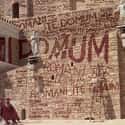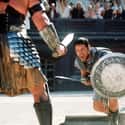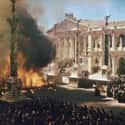-
(#1) Their Ships Were Rowed By Slaves
The Trope: Romans forced convicts and slaves to row their ships - often in chains and at the mercy of whips.
Why Is It Inaccurate? This trope was popularized in 1959's Ben-Hur, but according to the experts, there's little evidence to support it. As historian Alex von Tunzelmann writes in the Guardian,
Galley slavery was hardly known in the Roman empire, and there are no records of it being used as a punishment. Not least, this was because most Roman galleys – including the triremes shown in the film – required skilled rowers.
Tunzelmann adds that both Roman General Sextus Pompey and Emperor Augustus used former slaves to row their ships in the 1st century BC, "but these men were freed first, then took the job by choice."
The first solid evidence of chaining convicts to oars doesn't show up in the historical record until 1443 under France's King Charles VII.
Notable Offenders: Ben-Hur
-
(#2) Romans Left Their Marble Sculptures Unpainted
The Trope: Roman buildings, monuments, and statues were devoid of color, and part of an ultra-white marble landscape.
Why Is It Inaccurate? Romans, much like ancient Greeks, Egyptians, and Mesopotamians, added bright paint to the walls of marble structures and to statuary. Sculptures and statues, specifically, were painted to create a life-like representation of a person or deity. Hair, skin, and eye color, as well as ornate clothing, were all present.
When many Roman artifacts were essentially rediscovered during the Renaissance, they lacked color - the result of centuries of the elements stripping them of paint. Renaissance artists recreated the pure, natural look of marble statues, perpetuating the notion of artistic whiteness. During the 18th century, scholars like Johann Joachim Winckelmann, attributed ancient Roman artistic style to a sense of austere beauty, writing,
The whiter the body is, the more beautiful it is as well.... Color contributes to beauty, but it is not beauty. Color should have a minor part in the consideration of beauty, because it is not [color] but structure that constitutes its essence.
Dismissing what remnants of paint remained, Winckelmann helped establish a general assumption about Roman artwork that has only recently been corrected. More recently, researchers using ultraviolet, infrared, and microscope technologies have determined that Roman works of art were painted with elaborate, polychromatic flair.
Notable Offenders: Gladiator, Rome (TV series), The Fall of the Roman Empire, Monty Python's Life of Brian
-
(#3) Women Wore Revealing Clothing
The Trope: Roman women - across social classes - wore clothes to show off a lot of skin. Revealing clothing might be worn to emphasize attractiveness and sensuality, but it could also be a not-so-subtle indication of sexual manipulation.
Why Is It Inaccurate? Women in the Roman world were prone to show as little skin as possible when they left their homes. Married women demonstrated their modesty by layering clothes, something that also reflected a fair amount of wealth.
The more items a woman had on, the more clothing she could afford. A stola (similar to a toga and made out of wool) was worn over a tunic, which was topped off by a palla over a woman's head. Unmarried women and widows were not as concerned with keeping their heads covered and may or may not have donned a palla. While married women were covered from head to toe, lower-class women may not have worn a palla because it was a hindrance to work.
Clothes were generally more colorful and elaborately decorated depending on wealth, too. Women's garments could be one or many colors, but dyes used to color clothes were expensive. Colors like purple were reserved for only the most elite members of society and not appropriate for women.
Notable Offenders: Spartacus (TV series), Gladiator, Rome (TV series), Pompeii, History of the World: Part I
-
(#4) All Romans Spoke - And Understood - The Same Language
The Trope: Everyone in the Roman world spoke the same language and totally understood one another.
Why Is It Inaccurate? Movies are going to present Ancient Rome in a language the audience can understand, naturally. To a certain extent, there's a truth in a common language used among Romans. Latin was an administrative language in the empire, used by government officials and incorporated into military terminology for overall comprehension. That said, Latin was not the native language of most inhabitants of the greater Roman Empire.
As the Romans expanded their influence throughout Europe, into the eastern Mediterranean and across North Africa, they came into contact with numerous native languages. Different dialects of Latin took shape over time. Similarly, Latin influenced native languages present in these regions, a phenomenon seen in law and cultural practices, as well.
Notable Offenders: Monty Python's Life of Brian, Gladiator, The Last Legion, The Eagle, Gladiator, Rome (TV series)
-
(#5) Romans Just Slapped Latin Names On Greek Gods
The Trope: Roman gods were simply renamed versions of Greek deities, larger-than-life figures like Zeus, Hera, and Ares. Romans just adopted them as Jupiter, Juno, and Mars, with no additional beliefs or influences involved.
Why Is It Inaccurate? The Roman pantheon was really complex. Prior to the incorporation of Greek influence, however, Romans had a hierarchy of gods all their own. These merged over time, rather than the former simply replacing or supplanting the latter. The Roman state also associated itself with many gods imported from the Greek world. Honoring these deities - and, by extension, Rome itself - was a requirement. Festivals, rituals, and comparable activities kept gods and goddesses satisfied, offering prosperity and protection to the humans that honored them. Roman piety, according to Dionysius of Halicarnassus, was why Rome won so many wars and succeeded "in times of danger."
Romans also had an entire system of beliefs based on lesser deities. Lares, manes, and panes were spirits that oversaw aspects of daily life in Rome. Panes guarded the kitchen, lares protected the home, and manes were the spirits of deceased loved ones.
The introduction of gods from around the Roman Empire also influenced religious practices and beliefs. Mithras, a Persian god of war, was popular among members of the Roman military, while Christianity and Judaism were practiced with varied levels of acceptance or tolerance in the Roman world.
Notable Offenders: Immortals, Clash of the Titans, Hercules, The Twelve Tasks of Asterix
-
(#6) Everyone Wore A Toga
The Trope: Togas, togas everywhere. Togas were the garment of choice throughout the ancient Roman world, worn in public and in private by pretty much everyone.
Why Is It Inaccurate? Togas were exclusively worn by men, required at public gatherings as a way to acknowledge citizenship. Women wore a tunic, a stola, and a palla, layered to reflect concerns for modesty and to display social prominence. The togas that men wore had similar function.
As woolen garments were wrapped around a man's body - no fasteners required - togas were expensive. Togas could be plain, colored, or feature a stripe that indicated social and political status. A bordered toga with a large purple stripe was reserved for Senators, while lower political officials wore togas with smaller lines of the regal color. The emperor's toga, necessarily, featured the most purple of them all - dyed using highly prized Tyrian purple (derived from shellfish).
Togas also varied in length at various stages of Roman history. During the Republic, togas were shorter than those worn during the Imperial period. They were increasingly heavy and restrictive when it came to movement and comfort but further distinguished wealthy and notable Romans from individuals wearing simple tunics.
Contrary to how movies and television shows represent Romans, it was those simple tunics that were more prevalent in society. Free men, servants, and slaves all wore tunics and, due to the continued complexity of the toga, even magistrates wore them less and less often as the Imperial period progressed.
Notable Offenders: Gladiator; Rome (TV series); Agora; Pompeii; I, Claudius
-
(#7) Julius Caesar's Last Words Were 'Et Tu, Brute?'
The Trope: As Julius Caesar is attacked by his fellow senators, the final blow is struck by his dear friend Brutus. With his dying breath, Caesar expresses both shock and sadness in the Latin phrase, "Et tu, Brute?" (Which can be translated to "And you, Brutus?" or "Even you, Brutus?")
Why Is It Inaccurate? Caesar's last words are a matter of debate, even among the most ancient sources. In his Lives, Plutarch (writing between the 1st and 2nd century AD) reports that Caesar said nothing at all:
And it is said by some writers that although Caesar defended himself against the rest and darted this way and that and cried aloud, when he saw that Brutus had drawn his dagger, he pulled his toga down over his head and sank, either by chance or because pushed there by his murderers, against the pedestal on which the statue of Pompey stood.
In The Twelve Caesars, Suetonius (writing in the 2nd century AD) says historians differ on whether Caesar said nothing or addressed Brutus in Greek:
Finding himself now attacked on all hands with naked poniards, he wrapped the toga about his head, and at the same moment drew the skirt round his legs with his left hand, that he might fall more decently with the lower part of his body covered. He was stabbed with three and twenty wounds, uttering a groan only, but no cry, at the first wound; although some authors relate, that when Marcus Brutus fell upon him, he exclaimed, “What! art thou, too, one of them? Thou, my son!”
One modern scholar has a different read on Caesar's last words. Ioannis Ziogas argues that Caesar's Greek phrase, καὶ σύ, τέκνον, which can be translated to "You too, son," is actually a prediction of Brutus's doom:
The dictator’s oral epitaph predicts the death of Brutus as a consequence of his involvement in the assassination. It means "You too, son, will die." The Greco-Roman belief that a dying man can foresee the future invests Caesar’s last words with prophetic authority.
Notable Offenders: Julius Caesar (1953)
-
(#8) Romans Were Exclusively White
The Trope: Roman citizens throughout North Africa, the Middle East, and into Europe were Caucasian. If they appear at all, members of what we would now call "minority groups" were slaves and servants, excluded from the benefits of citizenship.
Why Is It Inaccurate? At one point, the Roman Empire spanned the entire Mediterranean Sea, and west from the Danube Valley into Britain. The vast number of groups under Roman authority ranged in ethnicity and appearance. While popular-culture versions of ancient Rome depict an overwhelmingly white population, archaeological, historical, and DNA evidence indicates the city was much more of a cultural melting pot.
In 2019, researchers published a study that analyzed remains from 29 sites in and around Rome. According to DNA evidence, large scale migration into the burgeoning city resulted in "overwhelming" genetic diversity through 300 CE, when the population of Rome topped 1 million. Historians continue to debate the extent to which this same type of diversity may have extended throughout the Empire.
Romans themselves would not have been as concerned with ethnicity or race as they would have been with cultural and political superiority. Roman citizenship was extended to individuals and groups based on economic and military considerations, a legal award intended to instill a sense of unity among residents in the empire. It was "inferior" peoples, regardless of color, who made up the ranks of slaves in the Roman world (i.e., prisoners of war, criminals, debtors). While this could include individuals with dark skin, there were no indications citizenship was not an option for peoples of various ethnicities and appearance.
Notable Offenders: Gladiator, Pompeii, Ben-Hur (1959), The Eagle, The Last Legion
-
(#9) Roman Buildings Were Constructed Entirely Of Marble
The Trope: All Roman architecture was constructed of pristine marble.
Why Is It Inaccurate? This trope can be traced all the way back to the Emperor Augustus himself, who is said to have boasted, "I found Rome a city of bricks and left it a city of marble.”
According to architectural historian Diane Favro, Augustus's legendary boast was probably overblown. Though the emperor did oversee the construction of many new temples and buildings, marble was primarily used as a facade - with less expensive (and less heavy) materials used for the main structure. In fact, the majority of Roman buildings were made of brick, wood, or concrete.
In 64 AD, under the Empror Nero (Augustus's great-great-grandson), the Great Fire of Rome destroyed much of the city - with three of its 14 districts completely incinerated, and many citizens left homeless. As Sky History explains, the fire was able to cause so much damage because "a lot of the civilian houses close to where the fire broke out were packed together, badly constructed and timber-framed, providing ample fuel for the fire to burn through during the dry summer conditions [emphasis added]."
Furthermore, Favro argues that Augustus was making a point about politics, not infrastructure. "Many scholars have looked at Augustus’s claim from a political standpoint, as a metaphor for him transforming a republic into an empire,” she explains.
Notable Offenders: Julius Caesar, Ben-Hur, Gladiator
-
(#10) Gladiators Always Fought To The Death
The Trope: Gladiatorial combat was a fight to the death for at least one, if not both, of the combatants. Onlookers enjoyed the spectacle of blood and carnage that unfolded before them, as criminals, prisoners of war, and slaves vied against one another for survival.
Why Is It Inaccurate? Gladiators were well-trained athletes and valuable commodities. Gladiators were managed by lanistae, men who invested a lot of money into their fighters. Because of this, it was in everyone's interest, including the crowd, to keep a gladiator alive and bring him back for future fights. Most gladiatorial contests ended in a serious wound (seen in the skeletal remains of gladiators) or when one of the two men ran out of energy.
Some gladiators may have been slaves or criminals at one point in their lives, and many were held in high regard - later freed when their days of fighting came to an end. Evidence suggests gladiators could even retire and become trainers in their own right.
Notable Offenders: Gladiator, Spartacus, Shadow of Rome (video game), Colosseum: Road to Freedom (video game), Rome (TV series), Spartacus (TV series)
-
(#11) Roman Battles With Barbarians Were Wild Free-For-Alls
The Trope: On one side of the battle, you have the well-equipped, disciplined Roman military. On the other, you have a group of barbarians with little training or formal structure. However, when the battle commences, pure chaos ensues.
Why Is It Inaccurate? The Roman military was incredibly organized and disciplined. There were some changes from the Republic to the Empire, but generally, Roman legions included between 5,000 and 6,000 men. Legions were divided into 10 cohorts, most of which had six centuries or roughly 480 infantrymen (the first cohort was slightly different). Centuries were divided into 10 contubernium of eight men each. There were additional cavalry, scouts, and non-fighting personnel that accompanied the legion. Groups had leaders, notably centurions, and provided a specific function on the battlefield.
The regimented and standardized structure of the Roman military streamlined warfare to a degree, allowing men to have uniform training in tactics and strategies that could be applied with greater efficacy. In the heat of battle, Romans were able to employ maneuvers like the tortoise-shell defense, often adapting them to specific circumstances, terrain, or enemy tactics. In Julius Caesar's Commentaries on the Gallic Wars, he discusses the lengths he and his men went to implement specific offensive and defensive strategies.
As the Roman military moved through the ever-expanding Empire, it came into contact with hostile groups of all kinds. Each "barbarian" force (barbarians simply because they weren't Roman) had its own type of fighting, weaponry, and tactics. Contrary to common beliefs that barbarian forces were wild men running around the battlefield, groups in Gaul, according to Caesar, were "well-trained (as they were) beyond all others to arms." Basically, they were skilled, just not as skilled as the Romans. When Tacitus wrote about German armies in his 1st-century AD work, Germania, he described a "fixed" number of men in "wedge-shaped formations," indicative of a more organized group of soldiers than commonly believed.
So, no, Roman armies and their opponents generally didn't run towards - and then smash into - each other with abandon.
Notable Offenders: Gladiator, The Last Legion, The Eagle, Total War: Rome (video game)
-
(#12) Senators Were The Only Politicians In Ancient Rome
The Trope: In ancient Rome, Senators called all of the shots. They were the politicians, the leaders, the trouble-makers, and were the only ones with actual political and social significance.
Why Is It Inaccurate? The Roman Senate developed during the earliest days of the city itself. Legendarily created by Romulus, the founder of Rome, the Senate advised early monarchs in Rome. They provided guidance to magistrates called consuls when they entered the political stage c. 509 BC, and soon the two institutions began swapping personnel to the detriment of members of lower social classes. Senators were patricians - Roman aristocrats - while plebeians (everyone else, except slaves) missed out on representation within the government. This led to the creation of tribuni plebis or "tribunes of the plebs," an assembly that could veto legislation put forward by the Senate.
Consuls, the Senate, and tribunes were accompanied by praetors, men who oversaw civil law, took on military commands, and served governors of Roman provinces. Aediles coordinated religious festivals, city administration, and social services in Rome, while quaestors were tasked with duties related to the Roman treasury. In the ever-present contest for power in Rome, offices were often limited by age, experience, and social class.
Throughout the Imperial period, many of the categories of officials split into more specialized categories and distinctions, with additional offices added to attend to matters related to religion and education.
Notable Offenders: Gladiator; The Fall of the Roman Empire; History of the World: Part I; Spartacus; Hannibal; Rome: Total War (video game)
-
(#13) It Was Commonplace For Romans To Have Orgies
The Trope: Roman celebrations, especially religious festivities, ultimately ended up in drunken, lust-filled orgies. When it came to elaborate Roman feasts, sexual perversions and debauchery knew no limits.
Why Is It Inaccurate? The myth of the Roman orgy emerged thanks to speculation by ancient writers and over-active imaginations across the centuries. During the 2nd century BC, the worship of Dionysus, called Bacchus by the Romans, involved a mysterious set of rituals that involved wine, food, and large groups of young men and women. After a report from the Roman Senate prompted persecution of the cult and its members, celebration of Bacchus retreated underground.
With a revival of concerns about loyalty to the Roman State came renewed interest in the cult. Roman historian Livy (d. 17 AD) wrote about the multi-day festival honoring the deity, the Bacchanalia of the late 1st century BC. As a staunch supporter of the Roman state, Livy viewed the Bacchus cult as a threat to Rome's very existence. As a non-member, however, his assertions that "men were mingled with women with all the license of nocturnal orgies, there was no crime, no deed of shame, wanting" were based on previous accounts and steeped in bias.
Livy's work does reflect a tool of propaganda used in the Roman world, however. Throwing accusations of sexual impropriety was commonly used against emperors and politicians to destroy their images. For example, Suetonius accused Emperor Caligula (d. 41 AD) of incest and of opening "a brothel in his palace."
Notable Offenders: Heliogabalus, Tyrant of Rome; Caligula; History of the World: Part I; Plebs (TV series)
-
(#14) The 'Fall' Of The Roman Empire Happened Overnight
The Trope: One day a bunch of barbarians arrived at the gates of Rome, sacked the city, and brought the Empire to an end.
Why Is It Inaccurate? The decline of the Roman Empire took place over decades, and arguably centuries. It was not one single event that toppled the ancient civilization but several factors, including economics, disease, and even climate change.
Eventually, the empire was divided into east and west, with the capital moving from Rome to Byzantium. Byzantium became Constantinople, named for Emperor Constantine (d. 337 AD), who had been one of four tetrarchs tasked with leading the overgrown empire. When Diocletian (d. 305 AD) introduced the institution of the tetrarchy during his reign, it split the Roman Empire into two parts - with each part led by a senior "Augustus" and a junior "Caesar." This move was intended to help protect Rome with greater efficiency, to address economic crises that plagued the 3rd century, and return a sense of order to the Roman sphere of influence.
While Rome and the Western Roman Empire did continue to decline and combat migrations of barbarian groups, the city never completely fell. The sack of Rome by Alaric and the Visigoths in 410 AD is often cited as the beginning of the end, with 476 AD considered by historians the official "end" of the Western Roman Empire. In truth, it reinforced its orientation to the east.
The Eastern Roman Empire continued to thrive, and transitioned to become what is now called the Byzantine Empire. It expanded under the reigns of a handful of emperors, but gradually contracted over the ensuing centuries. The Byzantine era finally came to a close when Constantinople was sacked by the Ottomans in 1453 AD.
Notable Offenders: The Fall of the Roman Empire, The Last Legion
-
(#15) Emperors And Governors Regularly Fed Christians To The Lions
The Trope: Imperial policy dictated punishment for Christians - individuals who either subversively or openly defied the Roman state - as execution by wild animal (damnatio ad bestias). Lions, most notably, were used to execute Christians while providing entertainment to those who watched.
Why Is It Inaccurate? Christians were persecuted, scapegoated, and executed in ancient Rome, there's no denying that. Emperor Nero (d. 68 AD) blamed Christians for a massive fire in Rome in 64 AD, and he ordered them to be arrested, "covered with wild beasts' skins and torn to death by dogs." After Pliny the Younger, governor of Bithynia (in Asia Minor), executed several Christians in 112 AD, he wrote to Emperor Trajan about the decision. Trajan assured him it was the right choice, but also said not to target Christians exclusively.
Rome was, on the whole, tolerant of most religions. However, Christianity was unique because it proclaimed loyalty to only one god, and this did not include the various gods who were formerly Roman emperors. Considered traitors, Christians were given the opportunity to renounce their faith and accept the pledge of loyalty to the Roman emperor or make a sacrifice to the gods. Many Christians refused, opting to become martyrs instead.
During the 2nd century AD, Bishop Polycarp resisted threats from authorities to throw him to wild beasts if he did not repent, but was ultimately burned instead. Third-century martyrs Perpetua and Felicitas similarly refused to renounce Christianity and were "condemned to die by the beasts." They were placed in an arena with a leopard and bull before being impaled by gladiators.
The important take-away from this is that Christians were handled differently by governors, emperors, and other officials tasked with their fate. There was no imperial mandate that Christians be fed to the lions. Rather, it was one of several possible options for punishment. The horrors of the beasts were later emphasized by Christian writers as they praised the heroism of early men and women who were slain for their faith.
Notable Offenders: Quo Vadis (1951 and 2001)
New Random Displays Display All By Ranking
About This Tool
Our data comes from Ranker, If you want to participate in the ranking of items displayed on this page, please click here.
























